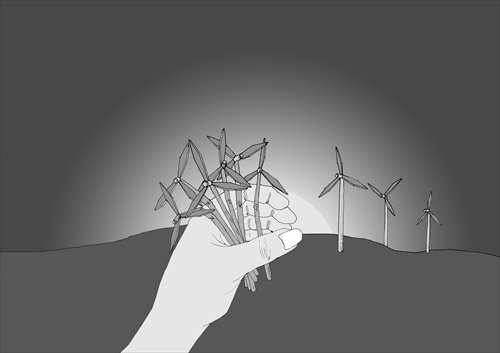Quota system can cut idle wind energy capacity

Illustration: Luo Xuan/GT
China's renewable energy industry accounts for half of the global production. With continuous upgrade in technology and cost reduction, China has seen the emergence of a host of leading new-energy firms. Currently, China has set a clear goal for developing its renewable energy industry - raising non-fossil fuel energy consumption to 15 percent of the total primary energy consumption by 2020.
It also has policies in place to support the industry and the manufacturing ability to achieve the goal. But how China can accomplish that goal efficiently to a large extent depends on the development path set by the government and its policy design. Development of renewable energy resources actually faces many challenges in China. The main issue is the difficulty in getting a return on investment, which is usually affected by on-grid electricity tariffs, grant of subsidies as well as curtailment of wind power generation.
So far, China has established an on-grid pricing mechanism and the problem of subsidies can be solved easily. Now the key problem is curtailment. The curtailment rate, or the rate of idle wind capacity, has gone up again since last year largely due to the oversupply of electricity. China's power consumption only rose 0.5 percent in 2015 while the utilization rates at the country's power plants dropped to an average of 3,969 hours, the lowest level since 1978. Power demand has remained weak so far this year. China aims to add 20 gigawatts of new wind power installations and 15 gigawatts of new solar capacity in 2016. If that goal is achieved, the curtailment rate may rise even higher and it will even be harder for renewable energy producers to make profits.
In a sign that there's been an alarming rise of idle wind capacity, the National Energy Administration, China's energy regulator, has recently asked local authorities in Gansu, Jilin, Heilongjiang, Inner Mongolia, Ningxia and Xinjiang to stop approving new wind power projects in a bit to prevent expansion of idle capacity.
A rush to build wind turbines in the past few years has resulted in many turbines standing idle as the capacity has far exceeded the grid's ability to absorb it. As a result, China resorted to curtailment, a practice of reducing wind power output. The country's wind power curtailment rate stood at 11 percent and 8 percent in 2013 and 2014, respectively. But the rate rose to an average of 15 percent in 2015. In Gansu, Xinjiang and Jilin, the rate was extremely high, exceeding 30 percent on average, with Gansu's rate approaching 39 percent.
Although some technical problems such as difficulty in connecting all wind power generation to the grid can be attributed to the rise of curtailment rate, the lack of sufficient demand in the market is now a key factor behind the increase in curtailment rate. Therefore, the country should make an effort to reduce the number of new installations and downgrade its renewable energy development goal to align the wind power output with the actual demand. Unlike the nuclear power plant which will take seven or eight years to build, wind power plants take shorter time to construct. So it will not be too late to build more wind power plants when power demand picks up in the future.
If the government insists in meeting the target of raising the shares of non-fossil fuels in primary energy consumption to about 15 percent by 2020, China needs to step up replacement of conventional energy with clean energy at the time when energy demand remains low. That also means the country needs to take more aggressive measures to address the problem of rising curtailment rate. Against the backdrop of low power demand, the most cost-effective solution is to implement quotas for renewable energy development.
Quota system and on-grid tariff system are two mechanisms supporting renewable energy development. Under the on-grid tariff system, the government sets the price of electricity produced from renewable energy sources and the utilities are obligated to purchase the electricity at a fixed price.
Under the quota regime, the government can require power generators to have a certain percentage of electric power coming from wind and other renewable energy sources. To provide flexibility in achieving compliance, "tradable renewable energy certificate" is granted to renewable energy plant operators for the electricity produced from renewable sources. Renewable energy plant operators may trade and sell the certificates to power generators. Their additional proceeds will rise in proportion to demand for the certificates.
The quota system is designed to encourage firms to develop renewable energy resources at a minimum cost through market mechanism and the returns are not fixed. The former is applicable to the preliminary stage of development of renewable energy sources while the latter is more suitable for the stage when their development is mature.
Feasibility of the quota system is related to the progress of the reform of China's electricity sector. The quota system is used on the pretext of market-based development of the electric power sector.
Currently China needs to address the serious problem of rising curtailment rate. Since the country has entered a mature stage of development of renewable energy resources, it is time for China to gradually shift to a quota regime from the on-grid tariff system to support the development of renewable energy resources, in line with the country's electric power sector reform. The quota system can help improve the competitiveness of renewable energy resources and reduce curtailment practices even if the power demand growth remains sluggish. The quota system will ensure that power generators and suppliers will take responsibility through market-based practices and allow additional cost to pass onto the consumers.
The author is director of the Collaborative Innovation Center for Energy Economics at Xiamen University. bizopinion@globaltimes.com.cn